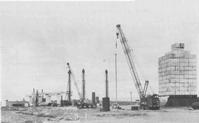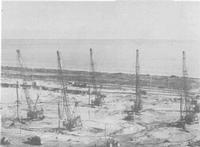


Chapter 6
I Construction During The Settlement Years
II The Use Of Timber As A Structural Material
III Structural Steel
IV Concrete Technology
V Housing
VI Industrialised Pre-cast Concrete Housing
VII Ports And Harbours
VIII Roads
IX Heavy Foundations
i Hawkesbury Railway Bridge
ii Impact of Floods
iii Hydraulic Jetting
iv Development Between First and Second World Wars
v Foundations Post-Second World War
vi Victorian Arts Centre
vii Bowen Bridge
X Bridges
XI Sewerage
XII Water Engineering
XIII Railways
XIV Major Buildings
XV Airports
XVI Thermal Power Stations
XVII Materials Handling
XVIII Oil Industry
XIX The Snowy Mountains Scheme
XX The Sydney Opera House
XXI The Sydney Harbour Bridge
XXII Hamersley Iron
XXIII North West Shelf
Sources and References
Index
Search
Help
Contact us

Foundations Post-Second World War
The post-war expansion of road systems in all States involved the construction of a number of major bridges, including a number with notable piled foundations.The Narrows Bridge, in Perth, incorporated 'Gambia piles' (so named because an early form of them were used in the Gambia), consisting of 31 inch diameter reinforced concrete cast inside a permanent steel casing. The casings incorporated 15 ft long reinforced concrete toe sections and were driven with a maximum length of 150 ft by means of a 12 ton drop hammer acting inside the casing.
In 1962, John Holland Constructions incorporated slender composite piles in their alternative design for the Captain Cook Bridge, Sydney, based on the research of Professor Francis and others at the University of Melbourne. With an overall length of 220 ft, they consisted of 20 inch square pre-stressed concrete upper sections joined to 14 x 14 1/2 inch steel H piles. These were, at the time, claimed to be the longest driven piles in the world; they may well remain the most slender. Soon after, construction of the Tasman Bridge at Hobart designed by Maunsell and Partners, utilised 52 inch diameter grouted 'Colcrete' piles cast inside steel casings, sunk by oscillation and grabbing to a maximum depth of 260 ft. Tests on some of these piles showed excessive deflection under load; this was remedied by a novel procedure of cyclic pre-loading developed by Dr. D. H. Trollope.
Westgate Bridge, in Melbourne, incorporated 5 ft diameter cylinders, sunk to a depth of 200 ft by oscillation and internal excavation, to which record test-loads (1500 tons of concrete kentledge blocks) were applied (Fig. 24).

Finally, a few years later in 1970, interest returned to the Hawkesbury River, where a world record was again challenged with driven hollow composite piles up to 283 ft long installed for a new expressway bridge.
Outstanding examples of deep ground compaction techniques, now part of the standard repertoire of foundation engineering, are provided by two major projects constructed in Western Australia in the early 1970s. Construction of a major freeway interchange and city car park in Perth involved the reclamation of some 90 acres from a stagnant reach of the Swan River. Underlain by some 40 to 100 ft of very soft organic silty clay, a complex system of vertical sand drains and surcharge loads speeded the consolidation of this layer (up to 23 ft of settlement was measured) to permit embankment construction within a reasonable construction period. To eliminate lateral and drag down forces on the piled foundations for the interchange structures, the 4 ft diameter pile cylinders were isolated from the surrounding material by 7 ft diameter steel caissons. The C.B.H. Grain Terminal at Kwinana was founded on Frankipiles installed over a 10 hectare site in a deep sand stratum which had been previously compacted to a depth of 80 feet by Vibrocompaction, a technique involving the use of vibrating probes (Fig. 25).

Organisations in Australian Science at Work - C.B.H. Grain Terminal, Kwinana; John Holland Constructions; Maunsell and Partners
People in Bright Sparcs - Francis, Prof. A. J.; Sewell, A. P.; Trollope, Dr D. H.
 |
Australian Academy of Technological Sciences and Engineering |  |
© 1988 Print Edition pages 352 - 353, Online Edition 2000
Published by Australian Science and Technology Heritage Centre, using the Web Academic Resource Publisher
http://www.austehc.unimelb.edu.au/tia/355.html